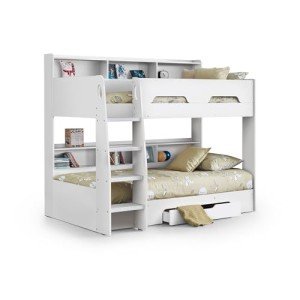What's The Reason Nobody Is Interested In Bunk Beds
Exploring Bunk Beds: A Comprehensive Guide
Bunk beds have long been a staple in children's bed rooms, dorm rooms, and even homes with minimal space. Not only do they offer a practical sleeping option, however they also develop an enjoyable and imaginative environment for children and a great space-saver for adults and families. This post will explore whatever you require to learn about bunk beds, from types and materials to safety pointers and buying recommendations.
Table of Contents
- Types of Bunk Beds
- Conventional Bunk Beds
- Loft Beds
- Triple Bunk Beds
- L-Shaped Bunk Beds
- Material Options
- Wood
- Metal
- Safety Considerations
- Buying Guide
- Frequently asked questions
Types of Bunk Beds
Bunk beds can be found in different styles to suit different requirements and preferences. Here's a breakdown of the most common types:
Conventional Bunk Beds
Standard bunks typically feature two beds stacked vertically on top of one another. These beds are ideal for brother or sisters sharing a space or for taking full advantage of sleeping space in visitor spaces.
Loft Beds
Loft beds stand similarly to conventional bunk beds but do not have a lower sleeping area. Rather, they typically incorporate a desk or seating area below, making them a great choice for little rooms needing multifunctionality.
Triple Bunk Beds
Triple bunk beds are developed for 3 residents, with beds stacked in a three-tier setup. These are less typical but can be a fun option for big families or pajama parties.
L-Shaped Bunk Beds
With one bed placed horizontally and the other vertically, L-shaped bunk beds are frequently geared up with extra functions such as desks or storage drawers and can match corner spaces in a space.
Comparison of Bunk Bed Types
Bed Type
Suitable Use
Description
Conventional
Shared bedrooms or guest rooms
2 beds stacked vertically
Loft
Little spaces needing multi-purpose space
Upper bed with open space below
Triple
Big households or slumber parties
Three beds stacked vertically
L-Shaped
Corner or versatile areas
A combination of vertical and horizontal beds
Product Options
Bunk beds are made from numerous products, with wood and metal being the most typical. Each product has its pros and cons.
Wood
- Sturdiness: Generally robust and can withstand years of use.
- Aesthetic Appeal: Offers a classic appearance that can blend with different designs.
- Weight Capacity: Typically stronger; can support heavier weights.
- Drawbacks: May be more pricey than metal options and can be vulnerable to scratches.
Metal
- Sturdiness: Generally light-weight and easy to move but still tough.
- Modern Design: Often can be found in sleek designs, making it appealing for contemporary spaces.
- Cost-efficient: Usually less expensive than wooden choices.
- Disadvantages: Can be cold to the touch in winters and may not have the same visual appeal for some buyers.
Security Considerations
When it concerns bunk beds, security can not be overlooked. Here are essential security ideas to keep in mind:
- Guardrails: Ensure that the top bunk has guardrails on both sides to prevent falls.
- Tough Construction: Check for a solid develop and tough materials to endure weight and movement.
- Weight Limit: Adhere to the manufacturer's weight limit for both the upper and lower bunks.
- Ladder Design: Choose bunks with a safe, easy-to-climb ladder and avoid any sharp edges or rungs.
- Age Restrictions: Most producers recommend that kids under the age of six must not sleep in the upper bunk.
Purchasing Guide
When looking for bunk beds, think about the following factors to discover the very best fit for your requirements:
- Space Availability: Measure the room size and ceiling height, guaranteeing there is sufficient space for the leading bunk.
- Bed Size: Decide in between twin, full, or bigger sizes based on your requirements and the size of the room.
- Style Preference: Consider the overall design of the bed room to find a suitable style.
- Reduce of Setup: Look for a bunk bed that is uncomplicated to assemble.
- Budget plan: Bunk beds are available in different cost ranges, so determine a budget plan before beginning your search.
Frequently asked questions
1. What is the recommended age for kids to sleep on the top bunk?
Kids aged six and older are generally recommended to sleep on the top bunk to minimize the danger of falls.
2. How can I make my bunk bed more secure?
To boost security, guarantee guardrails are properly installed and check that the bed is put on a flat surface area. Furthermore, encourage children to use the ladder thoroughly.
3. Can I transform a bunk bed into two separate beds?
Many bunk beds are created to be convertible. Inspect the manufacturer's requirements for convertibility functions.
4. What accessories are readily available for bunk beds?
Typical devices include bed linens, storage drawers, staircases instead of ladders, and tented canopies for a fun visual appeal.
5. How do I keep my bunk bed?
Routine checks for loose screws or structural stability can help make sure security. Dust the bed routinely and clean spills without delay to keep the products in good condition.
Bunk beds are versatile and a space-efficient solution for numerous living situations, from children's spaces to visitor lodgings. With Kids Bunk Bed and products offered, possible purchasers have a wealth of options to think about, guaranteeing a combination of usefulness and aesthetic appeals. By prioritizing safety and following the pointers laid out in this guide, individuals can discover the ideal bunk bed that suits their space and way of life, all while producing an enjoyable sleeping environment.
